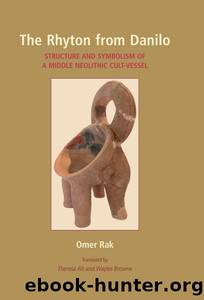The Rhyton from Danilo by Omer Rak Wayles Browne Theresa Alt

Author:Omer Rak, Wayles Browne, Theresa Alt [Omer Rak, Wayles Browne, Theresa Alt]
Language: eng
Format: epub
ISBN: 9781842175767
Barnesnoble:
Publisher: Oxbow Books
Published: 2011-02-28T00:00:00+00:00
8
THE VULVA AND THE PLOUGH
Like St. Michael and St. George, so too Cadmus, son of King Agenor of Sidon and his wife Telephassa, is famous not only as the founder of Greek Thebes, but also as a dragon slayer. After a long, unsuccessful search for his sister Europa, whom the god Zeus in the form of a bull had abducted, he decided, following the advice of the Pythia of the Delphic Oracle, to found a city. However, in the vicinity of the place where he intended to found it, in a cave near a spring, there lived a frightful serpent full of poison, belching fire, with three rows of sharp teeth and a dragonâs head, on which it flaunted a golden crest. When this monster, which belonged to the god of war Ares, devoured Cadmusâs comrades, whom he had sent for water so that he could offer a sacrifice to the goddess Athena, Cadmus engaged in battle with it and finally killed it by pinning it with a spear to the trunk of an oak. On account of that deed, which angered the god Ares, in old age he and his wife Harmonia had to go away to Illyria. On arrival there they both were turned into serpents, just as Athena had foretold to Cadmus after the killing of the dragon: âWhy, Cadmus, why stare at the snake youâve slain? You too shall be a snake and stared at.â (Ovidâs Metamorphoses 3.97â98).
R. KatiÄiÄ agrees that the legend of Cadmus on the Adriatic is surely the most significant mythological formulation of the old ties that had already in the Neolithic connected the Adriatic with the Aegean and of the movement of people and goods along routes offered by nature as links between once very distant regions (KatiÄiÄ 1989, 302). The struggle of the old Slavic god Perun with the serpent Veles is obviously nothing other than a transposition of the matrix of the Cadmus myth. Namely, in order to subdue the serpent god (Veles/Volos), who is down in the water, the source of riches, there appears, following texts of one proto-Slavic fertility ritual, Perun, an attribute of the Thunder God, whose feature is dryness, for his cult is above the water. In this opposition between dry and wet, which separates Perunâs sphere from Velesâs, a conflict arose between them near an oak. The conflict was provoked by the serpent god (Veles), who came up from his watery world into Perunâs sphere and captured the water/treasure. In this fight Perun, using his weaponry (a stone, hammer, lightning, thunder, an arrow), defeats his opponent above (on the mountain) and liberates the water (rains, treasure), thus restoring the disturbed order.1 In this way order in the world and its well-being are established by an equilibrium between these two forces: dry, transparent order, and wet, fecund disorder. The equilibrium is at once dynamic and antagonistic (KatiÄiÄ 2008, 193). This is a model that can be observed on the structural and symbolic level of the rhyton, or of the interaction of its parts: the âdryâ handle and the âwetâ receptacle.
Download
This site does not store any files on its server. We only index and link to content provided by other sites. Please contact the content providers to delete copyright contents if any and email us, we'll remove relevant links or contents immediately.
The Daily Stoic by Holiday Ryan & Hanselman Stephen(3194)
The Fate of Rome: Climate, Disease, and the End of an Empire (The Princeton History of the Ancient World) by Kyle Harper(2975)
People of the Earth: An Introduction to World Prehistory by Dr. Brian Fagan & Nadia Durrani(2673)
Ancient Worlds by Michael Scott(2576)
Babylon's Ark by Lawrence Anthony(2488)
The Daily Stoic by Ryan Holiday & Stephen Hanselman(2423)
Foreign Devils on the Silk Road: The Search for the Lost Treasures of Central Asia by Peter Hopkirk(2407)
India's Ancient Past by R.S. Sharma(2367)
MOSES THE EGYPTIAN by Jan Assmann(2347)
The Complete Dead Sea Scrolls in English (7th Edition) (Penguin Classics) by Geza Vermes(2203)
Lost Technologies of Ancient Egypt by Christopher Dunn(2172)
The Earth Chronicles Handbook by Zecharia Sitchin(2149)
24 Hours in Ancient Rome by Philip Matyszak(2025)
Alexander the Great by Philip Freeman(2009)
Aztec by Gary Jennings(1929)
The Nine Waves of Creation by Carl Johan Calleman(1841)
Curse Tablets and Binding Spells from the Ancient World by Gager John G.;(1817)
Before Atlantis by Frank Joseph(1787)
Earthmare: The Lost Book of Wars by Cergat(1762)
